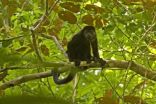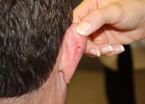(Press-News.org) Almost half of the tropical forest reserves in a new study are ineffective, according to results published in the journal Nature by William Laurance, research associate at the Smithsonian Tropical Research Institute now at James Cook University in Australia and more than 200 co-authors.
"Biodiversity is declining rapidly at reserves including Kahuzi Biega in the Democratic Republic of Congo, Xishuangbanna in southern China, and Northern Sierra Madre in the Philippines, among others," said Laurance. "Reserves that are doing relatively well include Bwindi Impenetrable N.P. in Uganda, Santa Rosa in Costa Rica, and Los Amigos in Peru."
Laurance asked experts who study plant and animal life across the Americas, Africa and Asia-Pacific to rate the effectiveness of the reserves where they have worked over the last two to three decades. Smithsonian coauthors include STRI staff scientist Joe Wright, and John Kress, Mercedes Foster and Louise Emmons at the National Museum of Natural History. They rated reserve health based on changes in abundance of 31 different groups from trees to primates.
"Reserves are like arks for biodiversity," said Laurance, "But some are in danger of sinking."
Even well-protected reserves mirror changes in surrounding landscapes. On the Smithsonian's Barro Colorado Island research station in Panama researchers recorded slight increases in exotic animals and plants.
Reserves suffering the most were those were encroached upon by illegal colonists, hunters and loggers. The bottom line, researchers say, is that we need to do a better job of protecting protected areas.
INFORMATION:
The Smithsonian Tropical Research Institute, headquartered in Panama City, Panama, is a unit of the Smithsonian Institution. The Institute furthers the understanding of tropical nature and its importance to human welfare, trains students to conduct research in the tropics and promotes conservation by increasing public awareness of the beauty and importance of tropical ecosystems. Website: www.stri.si.edu.
Reference: Laurance, William F., and 215 coauthors. 2012. Averting biodiversity collapse in tropical forest protected areas. Nature, DOI:10.1038/nature11318. Published online on 26 July 2012.
Tropical arks reach tipping point
2012-07-26
ELSE PRESS RELEASES FROM THIS DATE:
Researchers find new gene mutation associated with congenital myopathy
2012-07-26
Ann Arbor, Mich. — University of Michigan researchers have discovered a new cause of congenital myopathy: a mutation in a previously uncharacterized gene, according to research published this month in the American Journal of Human Genetics.
About 50% of congenital myopathy cases currently do not have a known genetic basis, presenting a clear barrier to understanding disease and developing therapy, says James Dowling, M.D., Ph.D., the paper's co-senior author and assistant professor of Pediatric Neurology at the University of Michigan's C.S. Mott Children's Hospital. Finding ...
Basal cell carcinoma risk can be chronic
2012-07-26
PROVIDENCE, R.I. [Brown University] — In the powerful sunlight of July, newly published results from a large study of people at high risk for basal cell carcinoma support the emerging view of the nation's most common cancer as a chronic ailment that often repeatedly afflicts older people but for which the seeds may be planted in youth. The research also found a new association with eczema.
"Basal cell carcinoma is a chronic disease once people have had multiple instances of it, because they are always at risk of getting more," said Dr. Martin Weinstock, professor of dermatology ...
High blood sugar, obesity increase risk for surgical site infection
2012-07-26
Two recent studies in the July issues of the Journal of Bone and Joint Surgery (JBJS) looked at surgical site infections and hyperglycemia, the technical term for high blood glucose, or high blood sugar. According to the first study "Relationship of Hyperglycemia and Surgical-Site Infection in Orthopaedic Surgery," high blood sugar is a concern during the post-traumatic and post-operative period and it may help to preoperatively identify a population of patients with musculoskeletal injuries who are at significant risk for infectious complications.
Nearly, one-third ...
Sum of the parts? How our brains see men as people and women as body parts
2012-07-26
When casting our eyes upon an object, our brains either perceive it in its entirety or as a collection of its parts. Consider, for instance, photo mosaics consisting of hundreds of tiny pictures that when arranged a certain way form a larger overall image: In fact, it takes two separate mental functions to see the mosaic from both perspectives.
A new study suggests that these two distinct cognitive processes also are in play with our basic physical perceptions of men and women -- and, importantly, provides clues as to why women are often the targets of sexual objectification.
The ...
Alpine Fault study shows new evidence for regular magnitude 8 earthquakes
2012-07-26
RENO, Nev. – A new study published in the prestigious journal Science, co-authored by University of Nevada, Reno's Glenn Biasi and colleagues at GNS Science in New Zealand, finds that very large earthquakes have been occurring relatively regularly on the Alpine Fault along the southwest coastline of New Zealand for at least 8,000 years.
The Alpine Fault is the most hazardous fault on the South Island of New Zealand, and about 80 miles northwest of the South Island's main city of Christchurch.
The team developed evidence for 22 earthquakes at the Hokuri Creek site, ...
ACR: Medical imaging study in health affairs incomplete and potentially misleading
2012-07-26
In response to a study published in the August issue of Health Affairs regarding declining medical imaging use in recent years, the American College of Radiology (ACR) released a statement explaining that physician education efforts and quality assurance steps have resulted in more efficient use of imaging, but that arbitrary Medicare cuts are damaging patient access to care. The ACR also cited a December 2011 Health Affairs article that shows Medicare imaging cuts may have resulted in physical harm to patients.
"This Health Affairs study further supports the fact that ...
Disabled Pakistani women abandoned, ignored after quake
2012-07-26
(Edmonton) Women who suffered spinal injuries in the 2005 Pakistan earthquake continued to endure hardships years later, including abandonment by spouses and families, according to new research from the University of Alberta.
Zubia Mumtaz, an assistant professor in the School of Public Health who studies how gender and class inequalities affect maternal health, worked with a team of graduate students to document the experiences of paraplegic women three years after the 7.6-magnitude quake that devastated Kashmir. They found that women—far more than men with similar spinal ...
NIH scientists identify likely predictors of hepatitis C severity
2012-07-26
Scientists at the National Institutes of Health have identified several factors in people infected with the hepatitis C virus that may predict whether the unusually rapid progression of disease from initial infection to severe liver conditions, such as cirrhosis, will occur. Knowing whether a patient's condition is likely to deteriorate quickly could help physicians decide on the best course of treatment.
The study was conducted by an international team of researchers led by Patrizia Farci, M.D., chief of the Hepatic Pathogenesis Section in the Laboratory of Infectious ...
NIH-funded study finds high HIV infection rates among gay and bisexual black men in the US
2012-07-26
WHAT:
The rate of new HIV infections among black men who have sex with men (MSM) in the United States, particularly younger men, is high and suggests the need for prevention programs specifically tailored to this population, according to initial findings from the HPTN 061 study. The preliminary results were presented at the XIX International AIDS Conference (AIDS 2012) in Washington, D.C., by study co-chair Kenneth Mayer, M.D., medical research director for the Fenway Community Health Center in Boston.
The HPTN 061 study, which involved 1,553 black MSM ages 18 and older ...
Controlling monkey brains and behavior with light
2012-07-26
Researchers reporting online on July 26 in Current Biology, a Cell Press publication, have for the first time shown that they can control the behavior of monkeys by using pulses of blue light to very specifically activate particular brain cells. The findings represent a key advance for optogenetics, a state-of-the-art method for making causal connections between brain activity and behavior. Based on the discovery, the researchers say that similar light-based mind control could likely also be made to work in humans for therapeutic ends.
"We are the first to show that optogenetics ...



